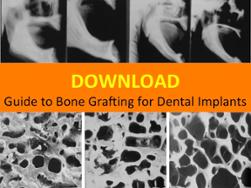Share this
Dental Implant Singapore- complex "re-treatment"
on December 29, 2015
 In Singapore, the profile of the dental implant patient is changing. It used to be that only affluent people with a high dental awareness (what some dentists call dental IQ) have dental implants to replace their missing teeth. Today, it is no longer the case. Implant dentistry has become mainstream dentistry. 25 years ago, there was only one main implant brand in Singapore. They practically controlled the number of dentists providing that service because they only sell implants to those who have attended their courses, for which there was a waiting list. Today, there are more implant brands here than I care to count and they are always recruiting dentists to attend their courses and buy their products. Competition is a wonderful thing. It has made dental implants widely available to patients at a significantly lost cost than it use to be. But along with that, there are also more problems. We are now beginning to see the next phase of implant dentistry in Singapore.
In Singapore, the profile of the dental implant patient is changing. It used to be that only affluent people with a high dental awareness (what some dentists call dental IQ) have dental implants to replace their missing teeth. Today, it is no longer the case. Implant dentistry has become mainstream dentistry. 25 years ago, there was only one main implant brand in Singapore. They practically controlled the number of dentists providing that service because they only sell implants to those who have attended their courses, for which there was a waiting list. Today, there are more implant brands here than I care to count and they are always recruiting dentists to attend their courses and buy their products. Competition is a wonderful thing. It has made dental implants widely available to patients at a significantly lost cost than it use to be. But along with that, there are also more problems. We are now beginning to see the next phase of implant dentistry in Singapore.
In my practice, I begin to see more patients coming in for treatment of their implant complications. Some problems can be easily solved. For example, if a patient developed infection around an implant, then we simply remove it, let it heal and then place a new implant. Sometimes, a bit of bone grafting is needed to replace the lost bone structure. A bit tedious, but nothing too difficult.
However, some cases are a bit more complex. For example, a patient with an implant replacing the upper central incisor that has developed some bone resorption and exposing part of the implant. This is an aesthetic nightmare. It is a difficult problem to solve because the implant is well integrated into the bone and removal requires removing the bone around the implant. However, after the removal of the bone and implant, there will be not much bone left and replacement with another implant will be very challenging. Multiple surgeries will be needed. First, grafting with an autogenous bone graft is done to increase the bone mass. This will recreate the width of the bone but not the height. After the bone graft has consolidated, distraction osteogenesis is done to increase the bone height. Distraction osteogenesis is a process whereby bone is cut and then stretched bit by bit on a daily basis until the desire height is reached. A few months later, an implant can be placed. Some soft tissue grafting may be needed to improve the aesthetic outcome prior to completing the treatment with restoration with a crown. The whole re-treatment may take many visits over 6-12 months to complete. Even then, the prognosis is still guarded.
increase the bone mass. This will recreate the width of the bone but not the height. After the bone graft has consolidated, distraction osteogenesis is done to increase the bone height. Distraction osteogenesis is a process whereby bone is cut and then stretched bit by bit on a daily basis until the desire height is reached. A few months later, an implant can be placed. Some soft tissue grafting may be needed to improve the aesthetic outcome prior to completing the treatment with restoration with a crown. The whole re-treatment may take many visits over 6-12 months to complete. Even then, the prognosis is still guarded.
The other type of re-treatment cases that is a real challenge are the full arch implant cases. These are cases whereby the patient has six to ten implants placed in one jaw and a fixed prosthesis cemented onto them. When some of the implants develop problems, re-treatment is often an arduous task. The prosthesis needs to be cut out to remove the infected implants. Thereafter, bone grafting is again needed to rebuild the bone before replacing the failed implants. A temporary prosthesis is needed during the treatment period before re-doing a final prosthesis when the new implants have integrated. The process may take 6-12 months to complete.
Re-treatment is always more difficult than the first time. The hard and soft tissues are compromised by the first surgery, making handling more difficult and healing less efficient. As such, it is important to have a team of specialists to manage this. A prosthodontist is needed to design a new plan and to transition the patient through the treatment phase by using a provisional prosthesis. This provisional prosthesis is also a diagnostic prosthesis as it provides information to construct the final definitive prosthesis. An oral maxillofacial surgeon is needed to remove the implants, rebuild the bone and replace the new implants. A good laboratory technician is needed to fabricate the prosthesis based on the design of the prosthodontist.
Some of these problems are preventable, others are not. Treatment philosophies change with time based on the scientific studies that emerge. While we strive to practice based on scientific evidence, not everything can be scientifically proven. A large part of clinical practice is an art. Two different dentists doing the same treatment on similar patients can have very different outcomes. Dentists should continually update themselves on new proven scientific treatment approaches and collaborate as a team to deliver the best outcome. Patients should spend some time to research which dentist or team is best suited for their needs.
Share this
- Jaw Surgery (93)
- Dental Implants Singapore (90)
- Orthognathic Surgery (48)
- Replacing Missing Teeth (26)
- Missing Teeth Options (23)
- Underbite (23)
- Bone Grafting (21)
- Costs (18)
- Facial Aesthetics (18)
- Aesthetics (17)
- dental implants (16)
- corrective jaw surgery (15)
- BOTOX (11)
- Dermal Fillers (11)
- Wisdom teeth (10)
- Fixed Implant Dentures (8)
- Loose Dentures Singapore (6)
- Medisave (6)
- sleep apnea (6)
- Braces (5)
- Dental Pain (5)
- Dentures in Singapore (5)
- Loose Teeth (5)
- Tooth Extraction (5)
- jaw deformities (5)
- bimax (4)
- bone graft (4)
- maxillomandibular advancement (4)
- all-on-4 (3)
- bimaxillary protrusion (3)
- chin implant (3)
- facial asymmetry (3)
- full mouth dental implants (3)
- genioplasty (3)
- immediate implant (3)
- removal of an integrated dental implant (3)
- third molars (3)
- wisdom tooth surgery (3)
- My Dentures Don't Fit (2)
- VME (2)
- bone graft healing (2)
- distraction osteogenesis (2)
- medical tourism (2)
- obstructive sleep apnea (2)
- orthodontics (2)
- plastic surgery (2)
- CT guided dental implants (1)
- Double jaw surgery (1)
- Invisalign (1)
- Periodontal Disease (1)
- Permanent Dentures Singapore (1)
- before and after photos (1)
- facial trauma (1)
- fractured dental implant (1)
- oral appliance therapy (1)
- root canal treatment (1)
- veneers (1)
- vertical maxillary excess (1)
- September 2019 (2)
- July 2019 (2)
- May 2019 (2)
- August 2018 (1)
- October 2017 (1)
- September 2017 (2)
- August 2017 (1)
- June 2017 (2)
- May 2017 (4)
- April 2017 (1)
- March 2017 (1)
- February 2017 (3)
- January 2017 (3)
- December 2016 (1)
- November 2016 (2)
- October 2016 (4)
- September 2016 (9)
- August 2016 (5)
- July 2016 (11)
- June 2016 (14)
- May 2016 (6)
- April 2016 (2)
- March 2016 (1)
- January 2016 (7)
- December 2015 (10)
- November 2015 (4)
- October 2015 (9)
- September 2015 (7)
- August 2015 (1)
- July 2015 (6)
- June 2015 (3)
- May 2015 (7)
- April 2015 (5)
- March 2015 (8)
- January 2015 (5)
- December 2014 (7)
- November 2014 (7)
- October 2014 (6)
- September 2014 (8)
- August 2014 (5)
- July 2014 (7)
- June 2014 (8)
- May 2014 (9)
- April 2014 (10)
- March 2014 (6)
- February 2014 (8)
- January 2014 (3)
Subscribe by email
Email subscription




Comments (1)